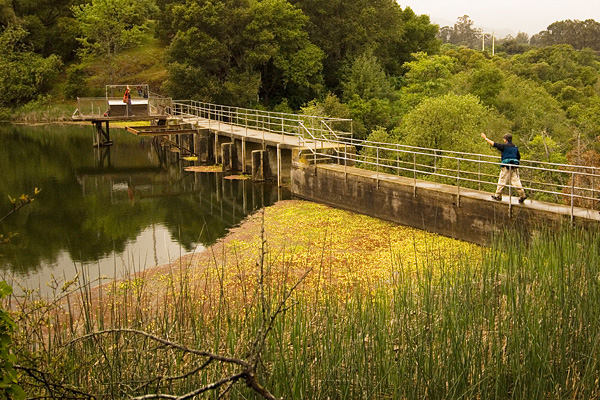Stanford begins comprehensive study of Searsville Dam
As a study of its future begins, Searsville Dam has been withdrawn from consideration as part of the university's proposed Habitat Conservation Plan. The historic dam, one of five on Stanford property, is considered important for irrigation, fire protection, habitat preservation, teaching and research. But sediment has greatly reduced its capacity.
The future of Stanford's Searsville Dam and Reservoir will be the subject of study by a team of faculty and staff members expected to come together as a committee by the end of the academic year.
Jean McCown, director of community relations, said members of the multidisciplinary committee will represent a wide range of university areas, including Jasper Ridge, Land Use and Environmental Planning, Sustainability and Energy Management, and Government and Community Relations. The group also will include faculty members whose research focuses on water and land management, biology and dam engineering.
McCown said members will report back their findings in about two years about the future of the aging but structurally sound dam, which is located in the Stanford foothills within Jasper Ridge Biological Preserve.
Committee members will consider the dam's future in light of such issues as the university's research and education activities at Jasper Ridge, its water supply needs, the environmental effects of the dam on habitats and wetlands, flood risks and the cost and effects of removing the reservoir's considerable sediment.
Among the possible outcomes of the study are:
- Continuing to allow the reservoir to fill with sediments and transition to a marsh and forested wetland.
- Maintaining the dam through sediment removal.
- Modifying the dam and reservoir to enable flood control, in addition to water supply and storage.
- Removing the dam to allow Corte Madera Creek and other streams to flow downstream unimpeded.
Withdrawn from HCP
As a result of the committee's creation, Stanford has withdrawn consideration of Searsville Dam and Reservoir from the Habitat Conservation Plan (HCP), which the university proposed to federal wildlife agencies in 2008. The HCP, which is still under consideration, outlines a comprehensive conservation program for five protected species on Stanford lands.
HCPs, made possible by the U.S. Endangered Species Act, allow landholders to create long-term conservation plans, rather than rely on short-term, limited mitigations for specific projects that might affect threatened or endangered species. The species of concern to Stanford include the California tiger salamander, steelhead trout, California red-legged frog, Western pond turtle and San Francisco garter snake.
In a January letter to the National Oceanic and Atmospheric Administration's Fisheries Service and the U.S. Fish and Wildlife Service, Catherine Palter, associate director of land use and environmental planning, explained that – in 2008, when the HCP was proposed – Stanford had not yet identified a process for addressing Searsville's future. So the proposed HCP, Palter wrote, reflected Stanford's "best effort" to cover Searsville operations and maintenance.
Now, three years later, Palter said Stanford knows much more about the complex issues surrounding the dam and, as a result, has been able to outline a process for considering its future. Withdrawing Searsville from the HCP gives Stanford needed time for study and analysis, while allowing the permitting process to continue for the remainder of the university's lands, McCown said.
For instance, McCown said the university hopes to proceed with other HCP proposals, including the creation of permanent easements along 13 miles of San Francisquito, Los Trancos, Matadero and Deer creeks, equaling about 360 acres of land. If approved, the HCP also would create a 315-acre California tiger salamander reserve in the lower foothills, where the university hopes to encourage a flourishing salamander population by building inviting ponds and maintaining tunnels across Junipero Serra Boulevard.
Although comprehensive, the HCP was never intended to be a planning document for Searsville Dam and Reservoir, McCown said.
Recreational past
Searsville – the only one of the Stanford dams located directly on a stream – was built in 1892 by the for-profit Spring Valley Water Company and acquired by the university in 1919. Historical postcards of the area show people riding around the lake on horseback and swimming in its deep waters. Today, however, the lake suffers from rapid sedimentation and low water quality. Sediment has reduced the water quantity to 10 percent of its original capacity.
Although no longer used for recreation, Searsville is crucial for Stanford irrigation, fire protection, habitat preservation, teaching and research. It is a major source for the 1 million gallons per day in non-potable water used at Stanford.
Palter called the many issues surrounding Searsville "very complex." For instance, among the issues the committee will need to study is the dam's status on the State of California Historic Resources Inventory as a very early example of poured-in-place concrete block construction.


Share This Story